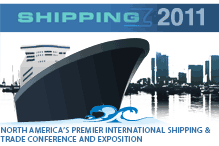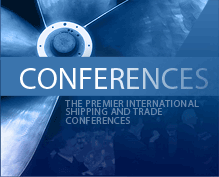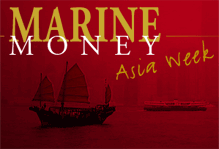
Facilitators – The Export Credit Award
Lending certainly becomes more palatable as risk is reduced and, interestingly, the guarantees provided by the export credit agencies (“ECA”) in support of their homeland’s exports accomplish just that. While bankers were in the main in denial when it came to straight lending, they fell all over themselves as export credit opportunities arose during the year and there were many. To provide a flavor of the opportunities, we summarize below some of the transactions that were nominated for this award.
The first transaction involved a drillship for Stena Lines, which was being constructed at Samsung with a ready for sea cost of $1.07 billion. Citi was the global coordinator as well as bookrunner along with BNP Paribas, Deutsche Bank and HSBC in an $850 million facility supported by Korean Export Insurance Corporation, as insurance provider and Eksportfinans, which provided $250 million in fixed rate funding, which benefitted from KEIC cover and syndicate bank guarantees. The Eksportfinans loan made the deal work by reducing the funding requirements of the banks and ensuring a successful syndication.
Continue Reading
Sponsor Support: The Private Equity Deal of the Year
In shipping, and in life, there are some people who stick with it when the going gets tough, others who don’t. While there is generally no explicit contractual obligation for a sponsor to use private resources to support a financially needy public company that they conceived, some nevertheless do – and we think that deserves to be recognized in these pages. With that as a background of rationale, we are pleased to award the 2009 private equity deal of the year to the founders of Seaspan for their proactive infusion of $180 million of preferred equity to strengthen the company’s balance sheet as it headed into market environment that they believed would put the company under stress, but ultimately provide countercyclical opportunities for growth that would benefit both the common and the preferred shareholders.
Continue Reading
“When It Absolutely, Positively Has to Be There Overnight” – The Equity Follow-on Award
This was the year of the follow-on offerings for the reasons enumerated throughout these pages. Follow-on share offerings and, later, high yield stepped into the breach created by the credit crunch. Risk appetite was prevalent, at least with established issuers, and dilution of seemingly small concern. Numerous deals were nominated and many were well deserving of this award. Shares were issued worldwide and many were extremely noteworthy including major offerings for NYK Lines, NOL and A.P. Moller-Maersk.
Led by DBS, J.P. Morgan, Morgan Stanley and HSBC, Neptune Orient Lines brought forth a $972 million rights issue, which represented the largest ever shipping rights issue globally and the 3rd largest in Singapore. With Temasek Holdings controlling 68% of the shares and agreeing to subscribe for it’s pro rata share as well as sub-underwrite the entire transaction, this was a straightforward transaction.
George and Deutsche Bank’s Convertible – Equity Linked Award
In a year when credit all but evaporated, the capital markets showed their importance by providing much needed capital to those companies established enough to access it. With the ship finance community increasingly convinced that the role of the capital markets will only increase while banks struggle to regain the balance sheet strength needed to lend, examining and understanding those transactions which are setting trends in the capital markets becomes valuable business.
As Marine Money scanned the seascape of notable equity linked transactions, which met the parameters of this Award – accessing capital in uncertain times, achieving competitively priced financing and of course unparalleled execution – it was abundantly clear that George Economou and the banking team at Deutsche Bank, led by Craig Feuhrer were at the top of the class.
It would, however, be unfair not to mention several of the other transactions, which must be considered significant for 2009. For indeed 2009 was a difficult year, make no mistake about it and any capital markets equity related deal must be considered superior.
A Means to an End – The Mergers & Acquisition Award
With bank financing being the lubricant for M&A deals, one might have expected little activity in this category. On the contrary, there were, in fact, a number of important M&A transactions done in 2009. One of the largest and most interesting was the sale by TUI AG of Hapag-Lloyd AG to the Albert Ballin Consortium. No longer a strategic fit to its business, TUI, with Citi acting as its advisor, began the process of selling the fifth largest liner company in 2008 and received indications of interest from both strategic and financial buyers. Agreement was reached with the Hamburg Consortium in October of that year as the perfect storm approached. Despite the many travails of getting the deal done in this period of uncertainty and weakness, the sellers, with the assistance of Citi prevailed, closing the transaction in March thanks to some creative structuring including the buyback of a 43.33% entrepreneurial stake.
Not to be outdone, the Asian market nominated the acquisition of a controlling stake (56.81%) in the PRC’s Tianjin Port Co. by the Hong Kong listed Tianjin Port Development for $1.4 billion. Advisors on the transaction were Merrill Lynch, Morgan Stanley and Citic.
Leveraging Opportunity – The Structured Finance Award
Throughout the year, many talked of opportunities, but little was done. Most felt prices were not low enough and, of course, the bank debt needed to achieve the required leveraged returns wasn’t there.
But to Angeliki Frangou and her Navios team, these were mere bumps in the road that were easily overcome through creativity and structuring. And as important as those skills were, the fact that Navios had both the reputation and the ability to get a deal done were perhaps as crucial in this instance.
In yet another innovative deal and one that is certainly representative of the times in which we find ourselves, Navios announced the acquisition of four newbuilding Capesize vessels, currently under construction at a South Korean shipyard. Three of the vessels were purchased from companies controlled by Commerzbank AG. The seller of the 4th was not disclosed.
From each according to his ability, to each according to his needs!
As one can imagine, there was no shortage of deals nominated in this category and the problems dealt with ranged from mere covenant breaches to debt restructurings with equity infusions. In the majority of instances, the main culprit was the breach of the loan to value covenant, one of the few covenants to sneak into the loan documents of the recent past. With cash flow and on hand liquidity sufficient to service debt, these were largely non-events but for the price extracted by the banks for the necessary waivers. The breach provided the leverage the banks needed to repair their balance sheets and offset their higher funding costs. For others, it was a matter of survival. Armada and Eastwind never made it out of triage, while CSAV and ZIM were eventually taken off of the resuscitator to survive another day. The common feature and what made each of these restructurings work is expressed in the quote from Karl Marx which begins this article or, perhaps more appropriately, the maritime concept of general average, under which all share equally in the risks of a voyage.
Many of the nominees are worthy of mention. AMA staked out a dominant position restructuring Norwegian high yield bonds used in the offshore sector. AMA represented the bondholders and won mandates in 7 deals, totaling over $2 billion. Solutions ranged from M&A processes, to the injection of new debt, to taking the companies through a structured bankruptcy.
Strategic Choice – The Public Debt Award U.S.
Reporting on transactions is difficult. Time is short and deadlines are tight. Much of the information one needs is available, but you rarely get to look under the hood. In some respects, transparency has not met everyone’s expectations. It does not allow you to read minds nor has it broken the SEC’s code of silence. And, finally it does not preclude misinformation, under the guise of “market talk.” It is difficult to correct misperceptions, while, hindsight, on the other hand, is always 20-20.
This year’s winner of the U.S. Public Debt award gave us the opportunity to explore this issue and fully grasp the thinking behind a deal. Against stiff competition, including offerings by Navios, AP Moller-Maersk and Hornbeck, the editors have chosen General Maritime’s (“Genmar”) $300 million 12% senior unsecured notes due in 2017 as this year winner in that category. JPMorgan and Goldman Sachs were the joint lead bookrunners with Citi, Credit Suisse, DnB NOR, Jefferies, RBS and UBS acting as co-managers.
PUBLIC DEBT AWARD – ASIA
Much to everyone’s surprise, 2009 was a bumper year for shipping bonds, particularly in Asia. With banks still largely on the sidelines, the bond market offers an effective avenue for shipping companies to raise big money. Based on Marine Money figures, total shipping bond volume in Asia reached a historical high in 2009, having risen 371% from USD 1.59 billion in 2008 to USD 7.49 billion last year. Clearly, the need for capital has never been more pronounced.
Breaking down the figures by countries, South Korean shipping companies raised the most money from high yield bonds. STX Pan Ocean, Hyundai Merchant Marine, Hanjin Shipping, SK Shipping, Korea Line and EUKOR Carriers had collectively raised USD 2.9 billion, representing 38.7% of the total shipping bond issuances in Asia. China took the second spot with USD 2.3 billion raised and Japan came in third, thanks to the massive bond offerings by the three mega carriers.
Continue Reading
The Good, the (Not So) Bad and the Ugly- Public Debt Award Europe
Don’t let the title put you off. In discussing the Norwegian bond market, the news is mainly good. According to Nordea’s Norwegian Bond Market Corporate Credit Report, the market not only returned in 2009, it was the second most active year, only surpassed by the record year in 2007. Total corporate issuance was NOK 60.9 billion compared to NOK 14.6 billion in 2008 of which high yield represented 41% in 2009. As of year-end, there were 170 active corporate issuers, 60 were active in the market last year and of these 10 were new entrants.
Risk was down as evidenced by the iTraxx 5-year Crossover Index of 50 European High Yield credit default swaps. In March, the index reached a record high of 1,150 bps and by year end the spread was down to 479 bps, a level last seen in the autumn of 2007 when subprime entered the stage. High yield spreads followed with the 5-year BB and 5 year B Euro industrial credit spreads tightening to 233 bps and 482 bps respectively. Although Norwegian high yield credit spreads have also tightened, they continue to trade at elevated spreads compared to the rest of Europe.







